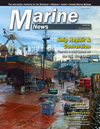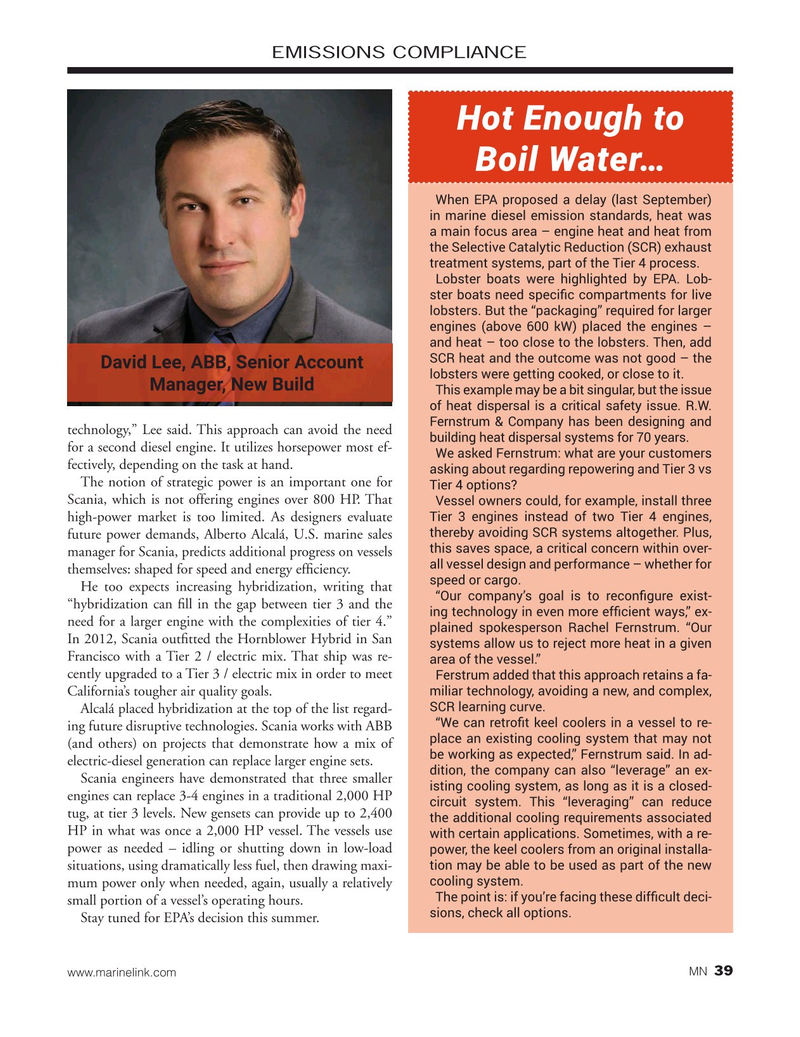
Page 39: of Marine News Magazine (March 2020)
Workboat Conversion & Repair
Read this page in Pdf, Flash or Html5 edition of March 2020 Marine News Magazine
EMISSIONS COMPLIANCE
Hot Enough to
Boil Water…
When EPA proposed a delay (last September) in marine diesel emission standards, heat was a main focus area – engine heat and heat from the Selective Catalytic Reduction (SCR) exhaust treatment systems, part of the Tier 4 process.
Lobster boats were highlighted by EPA. Lob- ster boats need speci? c compartments for live lobsters. But the “packaging” required for larger engines (above 600 kW) placed the engines – and heat – too close to the lobsters. Then, add
SCR heat and the outcome was not good – the
David Lee, ABB, Senior Account lobsters were getting cooked, or close to it.
Manager, New Build
This example may be a bit singular, but the issue of heat dispersal is a critical safety issue. R.W.
Fernstrum & Company has been designing and technology,” Lee said. This approach can avoid the need building heat dispersal systems for 70 years.
for a second diesel engine. It utilizes horsepower most ef-
We asked Fernstrum: what are your customers fectively, depending on the task at hand.
asking about regarding repowering and Tier 3 vs
The notion of strategic power is an important one for
Tier 4 options?
Scania, which is not offering engines over 800 HP. That
Vessel owners could, for example, install three
Tier 3 engines instead of two Tier 4 engines, high-power market is too limited. As designers evaluate thereby avoiding SCR systems altogether. Plus, future power demands, Alberto Alcalá, U.S. marine sales this saves space, a critical concern within over- manager for Scania, predicts additional progress on vessels all vessel design and performance – whether for themselves: shaped for speed and energy ef? ciency.
speed or cargo.
He too expects increasing hybridization, writing that “Our company’s goal is to recon? gure exist- “hybridization can ? ll in the gap between tier 3 and the ing technology in even more e? cient ways,” ex- need for a larger engine with the complexities of tier 4.” plained spokesperson Rachel Fernstrum. “Our
In 2012, Scania out? tted the Hornblower Hybrid in San systems allow us to reject more heat in a given
Francisco with a Tier 2 / electric mix. That ship was re- area of the vessel.” cently upgraded to a Tier 3 / electric mix in order to meet
Ferstrum added that this approach retains a fa- miliar technology, avoiding a new, and complex,
California’s tougher air quality goals.
SCR learning curve.
Alcalá placed hybridization at the top of the list regard- “We can retro? t keel coolers in a vessel to re- ing future disruptive technologies. Scania works with ABB place an existing cooling system that may not (and others) on projects that demonstrate how a mix of be working as expected,” Fernstrum said. In ad- electric-diesel generation can replace larger engine sets. dition, the company can also “leverage” an ex-
Scania engineers have demonstrated that three smaller isting cooling system, as long as it is a closed- engines can replace 3-4 engines in a traditional 2,000 HP circuit system. This “leveraging” can reduce tug, at tier 3 levels. New gensets can provide up to 2,400 the additional cooling requirements associated
HP in what was once a 2,000 HP vessel. The vessels use with certain applications. Sometimes, with a re- power as needed – idling or shutting down in low-load power, the keel coolers from an original installa- tion may be able to be used as part of the new situations, using dramatically less fuel, then drawing maxi- cooling system.
mum power only when needed, again, usually a relatively
The point is: if you’re facing these di? cult deci- small portion of a vessel’s operating hours.
sions, check all options.
Stay tuned for EPA’s decision this summer.
39 www.marinelink.com MN

 38
38

 40
40
